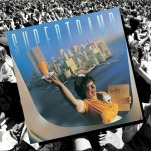Bear in mind, this scene takes place nearly an hour into the movie, once these two gunslingers have spent several days’ worth of story time warily eyeing each other. (In the best earlier bit, they wield dueling binoculars.) After writing “silent intimidation” above, I was momentarily chagrined to be reminded that there is some brief dialogue, but it’s significant that they each address only the Chinese bellhop, and their verbal communication remains pointedly indirect. As usual, Leone lets withering stares do most of the heavy lifting, though he’s in a playful enough mode here that he sticks mostly to medium and long shots, eschewing the extreme close-ups that signify a character’s impending doom. (Somebody should calculate the average elapsed time in a Leone movie between a pair of eyes filling the screen and a body hitting the ground.) What’s crucial is that Van Cleef gets just as much visual respect as Eastwood, so that by the end of the sequence, we’re no longer entirely certain who the movie’s hero is supposed to be.
Leone establishes that parity at the outset in the simplest, most direct way imaginable: He has Eastwood and Van Cleef change places. Once the bellhop does his unfortunate equivalent of “feets don’t fail me now”—remember, this is only a few years after the specter of Mickey Rooney in Breakfast At Tiffany’s—Van Cleef steps off the porch and into Eastwood’s face, casting a hilariously disdainful glance down at the other man’s less-natty attire. (Or maybe he’s just clocking the gun, but his expression really does imply, “Is that what you’re wearing?”) Eastwood counters by circling him, but only halfway, so that their positions are precisely reversed. Schoolyard boot-scuffing ensues, and for some reason, Leone doesn’t trust us to recognize that we’re looking at two overgrown kids; the scene’s sole flaw, brief reflexive racism aside, is the presence of the actual little kids watching from a distance, who are on hand expressly to underline that idea: “Just like the games we know.” Yeah, we’re on top of that, Sergio, but thanks.
What follows is extraordinary. My knowledge of Westerns isn’t encyclopedic enough to say just how familiar the hat-shooting routine was in 1965, but I’m pretty sure Leone didn’t invent it; no doubt that form of flagrant disrespect had been kicking around for quite a while. But very few filmmakers would have the confidence to extend the routine this far, or the chops to pull it off. One, two, three, four times, with no clever variations to speak of; Leone expertly varies the angle to heighten our spatial awareness, but he resists the temptation to make each rung of this horizontal ladder unique, or even to make any single one of them unique. In a strange way, he’s toying with our expectations—by the third iteration, it’s actively surprising that it’s the same damn thing every time. And I can think of nothing more badass than the immense dignity with which Van Cleef trudges to his hat’s new location and bends over to pick it up, knowing it’ll be shot out from under him, again and again and again, until he’s finally out of Eastwood’s range.
Of course, it’s easy to stay cool and collected when you know you can eventually turn around and perform the Old West equivalent of that move where Robin Hood splits the archery champ’s bull’s-eye arrow in half. It’s a hugely satisfying payoff, made all the more amusing by the equanimity with which Eastwood looks up at his own hat being turned into Swiss cheese. (Someone with a firmer grasp of physics than mine will have to weigh in on the plausibility factor. Seems to me a bullet would just penetrate a hat without moving it very far, if at all.) But remember: Eastwood is ostensibly our identification figure. He’s playing essentially the same character as in Fistful Of Dollars (the two films were released in the U.S. just four months apart, followed by The Good, The Bad And The Ugly the same calendar year), where he was unmistakably the hero, even though his motives weren’t exactly pure. We’ve viewed most of the previous action in this movie from his perspective. When he gets shown up here—not by a gang that has him at a numerical disadvantage, but by a peer with just as much steely courage and even deadlier aim—it complicates our loyalty in a way that’s truly exciting. Modern-day action movies (our version of Westerns, arguably) have plenty of Eastwoods, including Eastwood himself as recently as Gran Torino. Invincible demigods aplenty. But where are our Van Cleefs?










![Rob Reiner's son booked for murder amid homicide investigation [Updated]](https://img.pastemagazine.com/wp-content/avuploads/2025/12/15131025/MixCollage-15-Dec-2025-01-10-PM-9121.jpg)

























![HBO teases new Euphoria, Larry David, and much more in 2026 sizzle reel [Updated]](https://img.pastemagazine.com/wp-content/avuploads/2025/12/12100344/MixCollage-12-Dec-2025-09-56-AM-9137.jpg)



